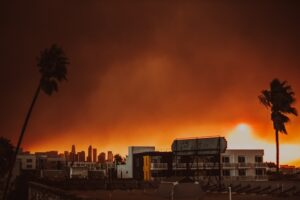Physical Address
23,24,25 & 26, 2nd Floor, Software Technology Park India, Opp: Garware Stadium,MIDC, Chikalthana, Aurangabad, Maharashtra – 431001 India
Physical Address
23,24,25 & 26, 2nd Floor, Software Technology Park India, Opp: Garware Stadium,MIDC, Chikalthana, Aurangabad, Maharashtra – 431001 India

In early January 2025, Los Angeles faced a series of devastating wildfires, including the Palisades, Eaton, Hurst, and Sunset Fires, which collectively scorched over 27,000 acres, destroyed more than 2,000 structures, and resulted in at least five fatalities.
The Palisades Fire, the largest among them, consumed nearly 16,000 acres and led to the destruction of approximately 1,000 structures.
Thousands of residents have been forced to evacuate, and the region grappled with severe air pollution as plumes of smoke blanketed the city.
These fires were aggravated by unusually strong Santa Ana winds, with gusts exceeding 80 mph, and severe drought conditions—the region’s driest period in 1,200 years.
Scientists are saying now that climate change has intensified these factors, leading to hotter, drier conditions that extend fire seasons beyond traditional months.
Climate Change’s Role
The 2025 wildfires have been fueled by the interplay of several factors, many of which were exacerbated by climate change. Southern California is in the grip of the most severe drought conditions in 1,200 years, with the area experiencing its driest period since the megadrought of the medieval era. This extended dry spell left vegetation highly flammable, effectively turning vast swathes of land into tinderboxes.
Additionally, January saw record-breaking heat, with temperatures soaring to unseasonable highs, further drying out the landscape. These factors combined with exceptionally strong Santa Ana winds, which reached gusts of over 80 mph, spreading flames rapidly and complicating firefighting efforts.
“Climate change, including increased heat, extended drought, and a thirsty atmosphere, has been a key driver in increasing the risk and extent of wildfires in the western United States,” the National Oceanic and Atmospheric Administration is reported to have said.
Crystal Raymond, deputy director of the Western Fire and Forest Resilience Collaborative at the University of Washington said, “Because of the warming trend of climate change, the vegetation is a little bit drier and the fire season is a little bit later. You get more of the chance for this dry season to then overlap with the Santa Ana wind season.”
Rising Risks of Longer Fire Seasons
Historically, wildfire seasons in California were confined to the late summer and early fall, but climate change has disrupted this pattern. Prolonged droughts, warmer winters, and earlier snowmelt have created conditions where wildfires now occur year-round.
Glen MacDonald, a geography professor at UCLA who studies climate change and wildfires, found in a study that the wildfire season in Southern California would, on average, will start earlier and last longer in the future, because of human-driven climate warming. A longer fire season increases the likelihood of fire-weather days coinciding with Santa Ana winds or human-caused ignitions, which account for over 90% of fires in Southern California.
The 2025 fires are emblematic of this shift, occurring during a month traditionally associated with cooler, wetter weather.
Urbanization and Fire Vulnerability
Los Angeles’ expanding urban footprint has also increased the risks. Communities encroaching on wildland areas, known as the wildland-urban interface, are particularly susceptible to fires. The Palisades Fire, for example, originated near such areas, where dense vegetation and human activity created the perfect ignition point.
Policy Implications and Future Strategies
The 2025 wildfires highlight the urgent need for climate-adaptive strategies, such as better land management, increased funding for wildfire prevention, and updated building codes in fire-prone areas. Experts stress the importance of reducing greenhouse gas emissions to curb the long-term effects of climate change while investing in short-term solutions like controlled burns, fire-resistant infrastructure, and community education.
References:
https://www.bbc.com/news/live/c5y81zyp1ext
https://www.washingtonpost.com/weather/2025/01/08/pacific-palisades-fire-map-california-los-angeles
https://phys.org/news/2025-01-negligible-months-southern-california-drought.amp
https://www.theguardian.com/us-news/article/2024/sep/06/heatwave-us-west-breaks-records
https://www.bbc.com/news/articles/clyxypryrnko.amp
https://time.com/7205622/california-wildfires-climate-change-conditions/#
https://www.theguardian.com/world/2025/jan/09/los-angeles-wildfires-climate-disasters
https://www.nature.com/articles/s43247-022-00344-6
Banner Image: Photo by Jessica Christian on Unsplash
Comments are closed.
[…] drought conditions and extreme heat, both of which are exacerbated by climate change. As experts have noted,the drying out of vegetation due to prolonged heat turns forests and grasslands into […]